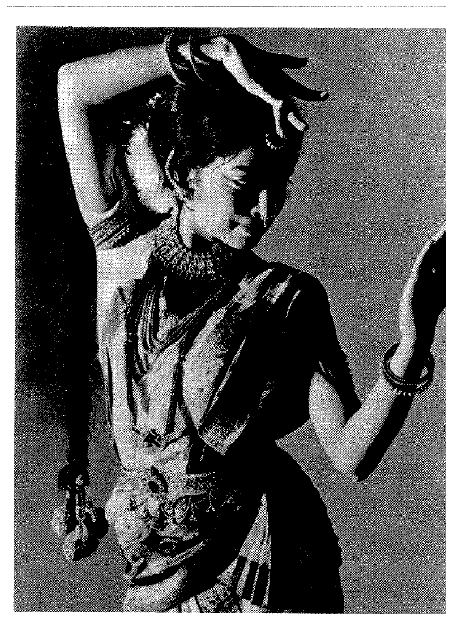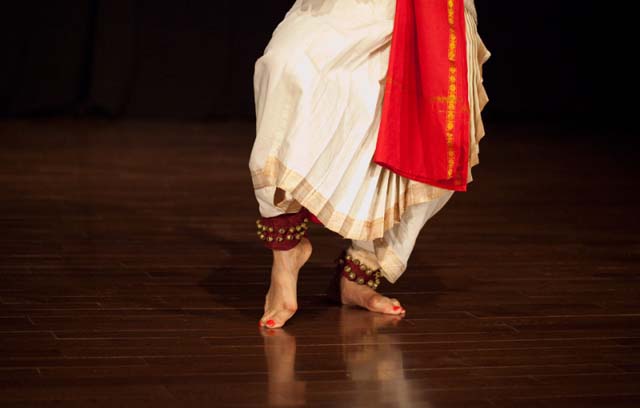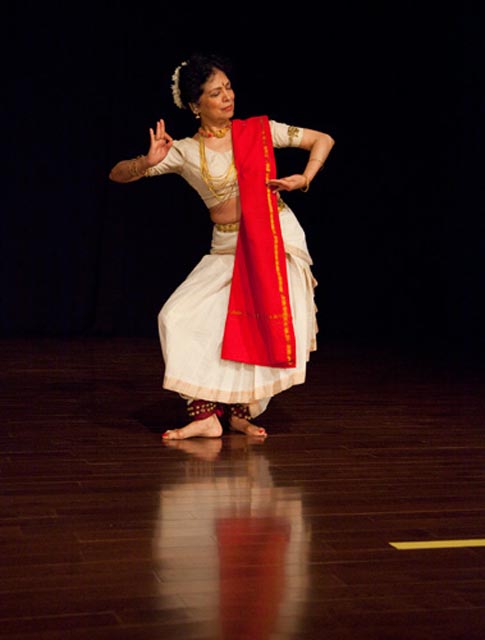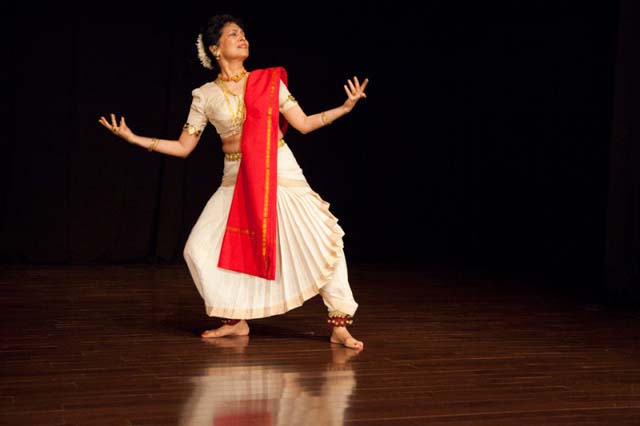
Indian Classical Dance Blossoms in New York…
While walking through the frenetic streets of Manhattan, have you ever been curious about what goes on in the buildings, behind closed doors? The first thing I spotted on the 5th floor of a building on 38th street was rows and rows of footwear lined up outside the door, neatly stacked. I dutifully shed my sandals too, and going inside found an Indian-style behthak in progress with silk cushions scattered on the woven carpet. Arts lovers, some with babies in tow, were already sitting cross-legged, facing the empty expanse of a large wooden floor. Musicians were tuning up their instruments, in anticipation.
The space is the Anamika Navatman Studios, an innovative organization for South Asian Arts and the production was Bhinna Pravaaha: Memories of a Performing Artist – Maya Kulkarni. This is a first undertaking to record and pay tribute to the noted artists of the past.
One of the delightful things about living in the tri-state area is that Indian dance and music are flourishing, and you are exposed to so many different artistes and art-forms. This day Shobana Ram and Samarth Nagarkar (vocal), Kedar Havaldar (tabla), Murali Balachandran (mridangam), and Vivek Rudrapatna (violin) were part of the ensemble. It was a rare performance by Maya Kulkarni, a noted Bharata Natyam dancer who had danced Carnegie Hall in the 70’s and of whom Anna Kisselgoff of the New York Times wrote in 1996, “a dancer of assurance and maturity whose dance was expressly poetic.”
Interestingly enough, Kulkarni has lived dual lives – she is also Dr. Maya Kulkarni Chadda, a professor of political science at William Paterson University in NJ, and part of the Council on Foreign Relations. Her two lives have rarely collided and so it was as she took to the stage in full Bharata Natyam regalia.
This was a rare treat, to sit in the middle of Manhattan in this informal setting and see the dancer and musicians up so close you could almost touch them. The weeping sound of the violin, the beat of the drums which get to your heart, the beautifully rendered lyrics – all much more immediate and effective seen in that small intimate auditorium. Nayikas, demons, Hindu Gods and Goddesses all populated the stage in the form of just one dancer, such is the power of dance and music.

After the performance, Maya Kulkarni did a one-on-one interview with dancer/choreographer Rajika Puri. She also shared some wonderful stories about growing up in India and how her first understanding of music and dance began with her father telling her ancient tales in Sanskrit and sharing plays like Kalisdasa’s Shakuntala.
Indeed, old stories never die; they just lie waiting – waiting to be re-awakened, relived, and retold.
The Dancer – Maya Kulkarni
Maya Kulkarni’s real life is almost as dramatic and colorful as her dance repertoire. Mahatma Gandhi, the Indian freedom movement, the works of Sanskrit literature, and the political life of independent India have been the canvas of her growing up years in Bombay, now known as Mumbai.
Her father, Gopalrao Kulkarni, was a writer and editor of Harijan, a newspaper published by Gandhi. Her mother, Nalini, was a political activist who also briefly served in the Indian Parliament after Independence. Her parents spent many months in jail during the freedom struggle, and were part of every satyagraha from Dandi March to the Quit India movement. Their lives were tied to Gandhi and they lived with him, and two of their sons were born in the ashram.
“My mother loved dance and my father music but neither had the opportunity to indulge as they were in and out of jails and lived in Sabarmati and Vardha with Gandhiji,” recalls Maya. “I am a post-independence child.”
After Independence, home was a big sprawling place in the suburb of Andheri in Bombay– and Maya describes it as an open darbar with all kinds of people coming and going. There were students and women in need, and at any given time, at least four or five people staying with them.
Gopalrao Kulkarni was also a formidable Sanskrit scholar and loved literature and poetry, and he passed on this passion to her, giving her the literary and poetic background ability to go deep into the meaning of metaphors and imagery. “It has been an extraordinary source for me to enrich the imagery of dance,” says Maya. Even the mudras or stylized gestures which are so much a part of traditional dance had their inspiration in the yagnas which were done in their Brahmin household.
Although she began her formal dance training under Guru Parvati Kumar, Maya picked up music and dance from an early age from the many needy students who would be nurtured by her parents.
Maya recalls that a music ustad used to come to teach her brother who was 8 years older, and though she never did train to sing, she picked up every bandish her brother sang. “I think I always had a keen ear for music,” she says. “This is what later became the main pivot of my dance style – musicality of dance.”

The Changing World of Indian Dance…
In today’s modern world, it is a different scene for dance and music students, but Maya recalls the power of the guru shishya parampara – the unmatched value of the student teacher relationship in the learning of the classical arts. As she explains, more than the actual dance training, it was the guru shishya relationship which enriched the student.
“It’s just being around your guru – you’re not actually dancing but listening to stories, experiences, so you draw from tradition by living it. When you can live dance, you can create it,” says Maya.
She recalls sitting for hours on end, day after day, and waiting for the gurus to teach – and yet the teaching was actually happening by osmosis. It was in the air, in the traditions all around one. It happened in the waiting moments, day after day, in the apprenticeship.
“In dance and music, it was learning the hard way with gurus who never measured time, who never measured seva,” she recalls. “We had to do seva for our gurus: I’ve pressed the feet of my guru, I’ve served him food, gone shopping for him, bought his medicines – and sometimes I’ve just sat and done nothing. You haven’t stood up and danced at all! This went on for years and years. Only when you can live dance can you learn dance.”
She adds, “My gurus couldn’t care less about money and time had no meaning for them. I can tell you what I learned in the process – discipline, patience and reverence. I also learned that the reverence for tradition was an invaluable gift.”
She realized the power of that gift only when she began her life as a dancer. “My gurus had put me in a place where I was in command of my art – I was in charge of my art and I knew it inside and out,” says Maya of that early training. “They had launched a traditional policeman in my head who would not allow me to do anything that was not part of the traditional structure.”
Yet, being separate from her gurus, she was able to create something new, something which was not part of their repertoire but was still in the classical tradition. She drew upon her Sanskrit philosophy and literature and applied it to dance, and it was the rigorous training from her gurus that made it possible. She says, “This is not easily found now – I was part of a life and time which is non-existent now.”

The Joy of Indian Classical Dance
In her latest performance, there is an innovative Carnatic-Hindustani music connection in her work. Asked if this was uncommon in Indian dance, she says, “Now less so because India itself is becoming increasingly more integrated, and cinema and travels have brought familiarity with hitherto ethnically separate cultural communities. But I was familiar with both styles of music and felt they had different strengths. Carnatic is beautifully structured and rhythmic; Hindustani explores the soul and mood and lends itself to Shringara, or love and romantic moods, better. ”
Asked about her greatest influences, Maya says, “My father and mother each have given me different kinds of gifts; my gurus who were the greatest known gurus of the traditional school – and in this I was just lucky to have gone to them – have shaped my being as a dancer.”
Can audiences expect to see more of Maya in the future? “I want to create a whole new set of lyrics and interpretation and when that is done I will perform again,” she says. “Unless I have something new to say, I do not want to perform for its own sake.”
Having been a part of the Indian dance scene for decades, where does she feel it’s headed? “Many interesting dimensions are being explored,” she says. “The young have a different mindset – they are less patient with themselves and with their emotions so they do not want to explore the inner life of a character, mood or emotion. That is the ultimate in our tradition for it is only that which creates rasa, the goal of all aesthetic activity according to our gurus.” She adds, “But the horizontal exploration of verity, so popular currently, is good too. It is sure to generate something truly beautiful.”
She feels this horizontal progression of art where dancers gather ideas from a whole variety of fields from modern art and architecture, modern sense of space, modern music is valuable too. But for her, it’s the old traditional way. “The traditional approach is linear, it’s an inward journey, a sinking within, going deeper and deeper to its original idea to its absolute essence, and then depicting it,” she says. “I don’t mix modern sensibilities in my art. That’s all I know.”
Ask her about the greatest joy that she has got from performing and she says, “I live for that moment when movement, music and emotions all blend to elevate the self beyond bodily existence. The dancer simply melts away and what remains is that indescribable state of being. Unfortunately not every time one dances one experiences it. But if one had, then you live for it. I have many times, but not often enough for me. To me that is nirvana.”
Next Page: The Vocalist – Shobana Ram

5 Comments
Pingback: Maya Kulkarni Chadda - The Woodstock Whisperer/Jim Shelley
Nice looking Indian classical dancer with actual talent. Beauty was in her feet with traditional foot bells, very beautiful feet…
Lovingly portrayed, Lavinia.You brought it all alive. New York is an amazing place for the unexpected surprises one encounters day after day. Kulkarni’s dual careers – fascinating.
I like Indian classical dancers’ beautiful feet with foot bells -ghungroos – it gives real excitement, pleasure and enjoyment.
Lavina
As usual, a beautiful story on Indian classical dance. We always encourage participation in classical and folk dances, and this will definitely encourage young people to learn more classical dance.